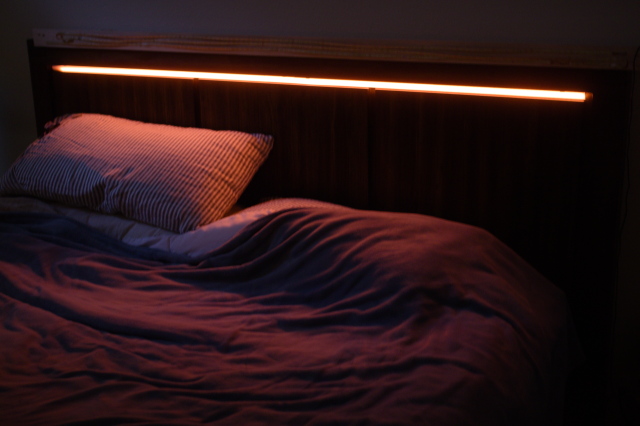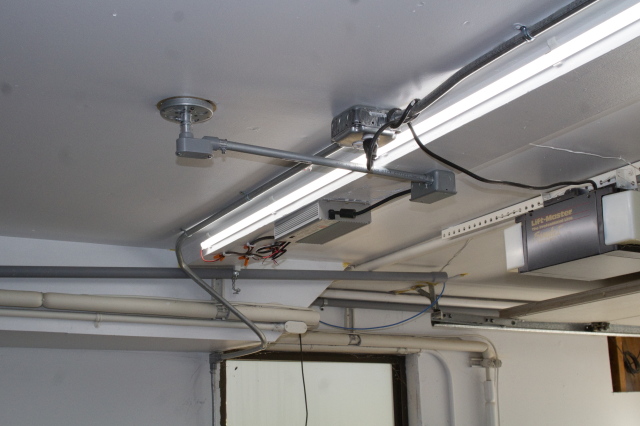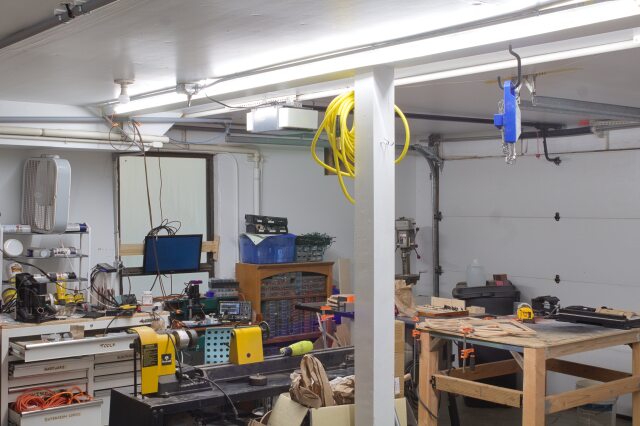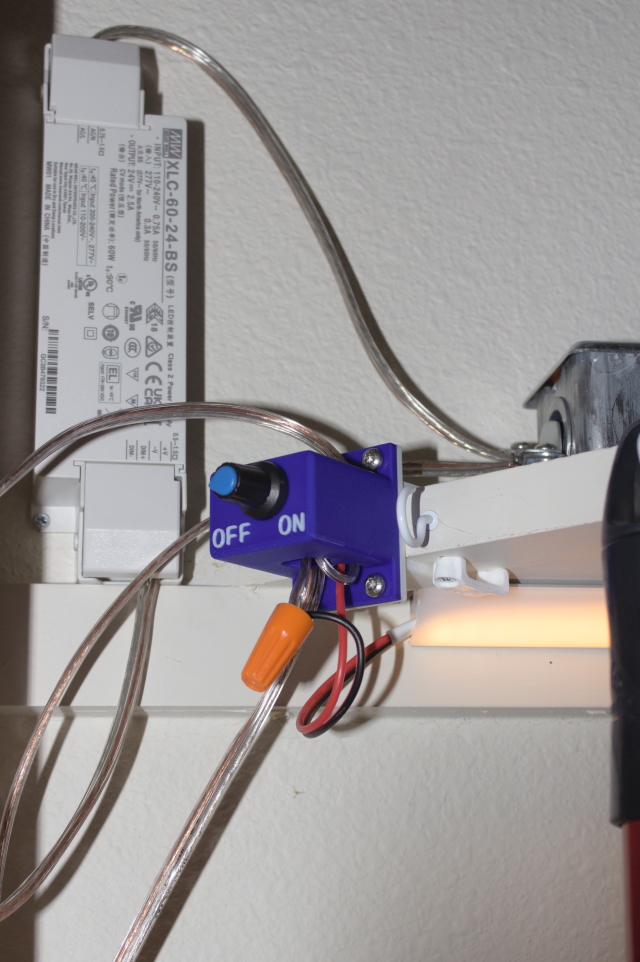TL;DR
To put up custom lighting, you need LED strips, aluminum channel, a power supply and (optionally) a dimmer. Many PSUs come with built-in dimmers which are okay for the range they support, and of course you don't always need/want dimming.
If you just want the BOM. Search "what I used" and "what I bought" below to find that.
There are pictures at the bottom.
Introduction
I recently decided to upgrade my garage lighting, which when I moved into my house, consisted of two bare 60W-equivalent bulbs in the ceiling. My initial plan was to get a couple T8 fluorescent tube fixtures, replace the existing A19 fixtures with those, and be done. These days it's cheaper and nicer to use LEDs rather than fluorescents, though the T8 form factor stays the same.
This led me down a long rabbit hole of questions that, for some reason, nobody selling LED lights or fixtures feels a need to answer:
- Fluorescent fixtures have something called a "ballast" which I guess is kind of like a transformer. People on message boards say that if you have LED lights you can just bypass this. Nobody says how to do this so I guess I can assume it will be obvious once I have the fixture in my hands?
- Why can't I just buy a fixture without a ballast? (They exist on Amazon, okay, but why wouldn't the people selling the LED tubes also sell them?)
- Conversely, why do all these tubes expect 120v AC as input? Do they have power conversion hardware inside of them that will flicker and die long before the LED does (sounds like "yes")? Why can't I just run DC to them myself? People on message boards talk about installing a "driver" near my panel and then running DC to the lights, which sounds like what I want, except that none of the bulbs I looked at would accept DC. What is going on?
- My criteria for lights was (a) do they have some sort of warranty, and (b) how bright are they, in terms of lumens? Is there something else I'm missing?
Fortunately I have a few friends who understand lighting and were able to set me straight. It turns out a much more flexible and straightforward way to install LED lighting is:
- Obtain LED strip lights, which take 12- or 24-volt DC, can be strung together in arbitrary ways and come in high brightness with high color quality. (My experience with strip lights was mostly in the form of 5-volt RGB lights on clearance at Home Depot. I guess these were not representative.)
- Obtain aluminum channel with diffuser to install the lights. Then they will be mounted securely and in straight lines. (Mysteriously, nobody who sells these strips sells these channels, or even hints that they exist.) Obtain some crimp connectors to connect the strips to each other and to your wiring.
- Obtain a 12- or 24-volt power supply from some power supply company (I used TRC). All the good supplies are made by Meanwell. Mysteriously, the people who sell LEDs mostly do not sell them (Yuji has one product), so you have to look elsewhere.
- If you are installing lighting you want to look at, get "high-CRI" lights, which produce a broad spectrum of light resembling daylight. The lighting you get at Home Depot, for the most part, is "low CRI", and these lights are why everything in, for example, Home Depot, looks weird and poorly-defined. (This is not inherent to LEDs, or because they aren't bright enough, or the wrong color, or flickering, although all those things might be true. It is because they are putting out a couple narrow frequencies which look white together when you look directly at them, but which cause differently-colored materials to look the same when reflected.) "Lumens" and "temperature" are important but CRI is just as important, even though nothing sold at Home Depot lists this spec.
LED Strips
I bought 25 meters (5 rolls) of 5600K and 2200K lights from Yuji since these were on clearance for $180 per set of 5, as well as some strip-to-wire and strip-to-strip clips. (I never used the strip-to-strip clips but it seemed good to have some around in case I mis-cut stuff.) They handed off to DHL, who then requested an additional 60% in tariffs and fees, which I was annoyed but not totally surprised by. Even with the tariffs these strips were way cheaper than I could find anywhere else.
I also had trouble with Paypal and wound up needing to send Yuji a bank wire to pay for the lights, and they had stock issues and needed an email confirmation to substitute a part, so it took several weeks for everything to arrive. Everyone was friendly and helpful but I was not thrilled with the this uncertainty and delay.
I also bought some A19 bulbs from Waveform Lighting, who shipped quickly from the US and charged me neither shipping nor tariffs. But they did not have 75%-off clearance deals, so their strip lights are significantly more expensive. Pick your poison I guess.
The strips come in 12V and 24V versions. The 12V ones have twice as many cut intervals, but require twice the amperage which means you'll need heavier wires and drop more voltage on long runs.
I intended to buy everything in 24 volts but misclicked somewhere so the 2200K lights were 12V when they arrived. Okay. I cut the strips in half and wired them in series, which I figure is fine as long as both segments are the same length and came from the same original reel. (ChatGPT suggested I could implement a bunch of protective electronics using a zener and a SCR and so on, to prevent either strip from dropping more than 12 volts even if the other one failed short somehow, but I didn't bother, mainly because both Mouser and Digikey have impassable captchas so I only buy electronic components from ebay, which is super inconvenient. If you are running a business and wondering whether it loses you customers when you IP-block them and harass them when they try to use your website, the answer is yes. Obviously. Lowes does this too. As does ebay, but not as frequently.)
Ultimately, I bought
- 25m 5600K 24v YJ-BC-RB-2835L-24V-56 (5 reels of 5m)
- 25m 2200K 12v YJ-BC-RB-2835L-12V-22 (5 reels of 5m)
- 5m "dim to flamewarm" YJ-WL-HRB-DTF-2835-24V-3012 (originally ordered 1250K "flamewarm" YJ-FW-RB-2835-24V-G01-12 but they substituted the more expensive transition ones)
As elaborated below, these are all listed as drawing 16-18 watts per meter, so 55 meters of lights is nearly a kilowatt of LEDs. Intuitively, given that normal A19 LED bulbs are 8-11 watts, this is something like buying 100 light bulbs. But I didn't know what things would look like so I figured I should err on the side of having unused product rather than not having enough lighting. As expected, it turnout out I significantly overbought.
What I used:
- Two 5m reels of 5600K lights in my garage; I believe a third would be useful but I don't have a good place to install them which wouldn't be blocked by the bay doors when they are open.
- One 5m 2200K reel in my living room, which is usually dimmed to half brightness or less
- 8m of 2200K reels, 2m on each shelf, in my pantry, which are usually set to minimum brightness
I also installed the 5m "dim to warm" lights, 2m in my bedroom and 3m in my bathroom, which is a good amount of light and which I use the full brightness range on.
This leaves me with three 5600K reels, two of which I gave to my dad, and two 2200K reels. I'm sure they will find some purpose. Though frustratingly, most of my remaining lighting needs are outdoors, and none of these lights are waterproof (nor can I even find high-CRI waterproof strip lights anywhere), limiting my options.
I wonder if I can put these strip lights in the conduit then paint over them with shellac or something to make them waterproof? Will experiment at some point.
Power Supplies
I bought a pile of Meanwell XLC-60-24-BS power supplies from TRC Electronics, as well as a HLG-600H-24AB. My intention was to put up 2-5 of the 5600K strips along the perimiter of my garage. The lights were listed 18 watts per meter, and given that my existing bulbs were 11 watts each, so I was pretty confident that I would not actually want 25 meters (450 watts, or around 2500 equivalent incandescent watts). But again I've never done this before, so I didn't know. I figured I could give anything I didn't need to my family or neighbors.
So the 600W HLG supply was for the garage, on the off chance I really did want 450W of lights in there.
Then the 60W XLC supplies were for "around the house", where I planned to put various 2200K strips, for example under my pantry shelves.
Meanwell's data sheets are missing a lot of information, and they didn't reply to my emails. (I think that TRC would have, but it didn't occur to me to email them until after I'd made an order.) So I had several questions going into this.
In particular,
- Some Meanwell PSUs are advertised as supporting PWM dimming, but the XLC series and HLG series are not. The data sheet seems to show the dimming functionality working by current limiting, which means that the dimming will have no effect until it reduces the limit below what the LEDs would naturally draw, and after that it will work by dropping voltage. Right? Well, this page on Waveform's site claims that the HLG series does use PWM, and emphasizes that the output PWM frequency is independent of the input PWM frequency (if you use a PWM signal for dimming). This is the only source for this claim online, and it does not cite anything, and it does not answer what the output PWM frequency is.
- The XLC series is a CV supply, and not a "CV-CC" supply. What happens if I attempt to draw too much current from it? The datasheet seems to imply that it will just shut off, at least at some high threshold. What happens below that threshold?
- What is the time average for the power limit of a "60W supply"? If I try to draw 90 watts, but through a 50% PWM duty cycle so that I'm only drawing 45W when averaged over a few milliseconds, is that okay?
- The HLG supply has three wires labeled "RC+", "RC-" and "+5VSB". These are labeled in the data sheet but never described. What do the RC wires do? What is the 5V reference relative to? Why would I want a 5V reference when the dimmer circuit and basically all analogue HVAC signals are 0-10V?
On the theory that "probably this stuff will just work, otherwise forums would be full of people asking and answering these questions", I just bought the supplies without knowing the answers. But now I can answer them for you:
- No, neither the XLC or HLG does PWM dimming. They both work by lowering the current limit of their DC output, which if they're not fully loaded, means doing nothing for a bit, dimming for a bit by voltage lowering, then dropping to 0 once you reduce the dimming input below the 10% minimum threshold. (For the HLG-600 this means that I can dim to a minimum of 60W using the built-in dimmer, which obviously is still enough to light my garage. Don't try to use this PSU for dimmable accent lighting, unless maybe you have a huge area to cover.) The Waveform page claiming otherwise is simply lying, and I suspect that a LLM wrote it.
- You can over-draw from the XLC supplies and they will just current-limit, for pretty big values of "over-draw". In particular you can hook up a 90W string of LEDs to a 60W supply, and it'll just put out 60W by lowering its output voltage a bit. The supply does get pretty hot, and the data sheet helpfully has a graph of how much you'll shorten the life of the supply by running it hot. (At 90 celsius the MTBF is about 2 years, and above that it has a temperature shutoff. At 65 celsius and below, it's over 11 years. So there's a big cost to running these hot. My supplies are heatsinked against my wall and I can hold my hand against the case for about 10 seconds before it hurts too much, so I'd swag that they're running over 65C but not by much.)
- I put a 10KHz PWM dimmer on the DC output from the XLC and cannot observe any overshoot or other problems caused by drawing "90 watts times a 50% duty cycle" from a 60W supply. As far as I can tell this Just Works.
- I still have no idea what the deal with the RC/5VSB wires on the HLG-500 are. I just tied them out of the way.
Dimming
As described above, while the Meanwell supplies I purchased have dimming support, the range is pretty limited. For the garage lights this is fine; I leave the lights at full brightness almost all the time. For living spaces I would say that the Maxwell supplies' dimming is not useful, and to not even bother buying ones that support dimming.
Instead, I use a PWM controller to dim the lights. Strangely, these were very difficult to find -- eventually I typed "pwm mosfet breakout" into Amazon to find these, which are labeled as "LED dimmers" but didn't show up on my searches. None of Yuji, Waveform, TRC, Jameco sell these things even though they're useful and necessary for anybody buying DC LED strips, and general searches for light dimmers overwhelmingly show up with in-wall triac dimmers and other inapplicable junk. And even after finding a usable search query, all I got were breakout boards with no case. Clearly there's a market gap here.
Anyway, these are listed as being 10KHz PWM dimmers which will dim to 1%. Indeed, my scope shows a very clean square wave that smoothly changes shape from full DC to 0 (though below 10% there is a bit of voltage overshoot, at least with a small dummy load, which is presumably the fault of my power supply rather than dimmers). For $1 a piece I am super impressed with them. I mentioned these dimmers to Greg and asked if he wanted any, and he said he didn't like this sort of product due to RF noise, and said I should just vary voltage. I was worried that this would cause color distortion. (I tried it and I was wrong; the colors are fine when underdriving the strips.) But I don't do much radio stuff and the PWM dimmers are super easy to use so I kept them, against his advice.
In practice I can't actually dim the lights to 1%; they shut off completely below some minimum threshold. I'm unsure if this is the fault of control circuitry on the LED strips (though there seems to be almost none) or my power supplies, or because the LEDs themselves have capacitance and my PWM frequency is too high. But overally I'm quite happy with the result.
On Bypassing Ballasts
I mentioned above that if I'd bought fluorescent light fixtures I would be expected to disconnect the ballasts in order to use LED tubes. At the start of this project this seemed like a lot of unknowns and like I would waste money wrecking my fixtures and/or my lights. I never pursued this but after messing around with all this stuff I now feel confident that I would've "figured it out" and not wrecked anything.
Indeed, having learned that LED lights are typically configured as an independent PSU and then a dumb DC light strip (with the exception of integrated A19 or T8 "bulbs" which I now see are a kludgey historical accident), I popped open the ECL 32-30-3 under-cabinet LEDs that came with my house.
(These didn't come apart very easily; I wound up prying them apart with a chisel and then hammering them back together, wrecking the paint and visibly deforming them. But they're under-cabinet lights so you can't see them so whatever. As my friend Kurt says, "nothing is permanent" and it's not a problem if you use a hammer and chisel to remove or reconfigure stuff.)
Anyway, when I moved in these lights were visibly flickering at all brightnesses, and had a triac dimmer switch whose lowest setting was so bright that I would flinch each morning making coffee. Emboldened by installing the new lights, and discovering that the replacement value of these units is $40 on ebay I pulled them open to find that they consist of (a) a UCP-20U-480-36 480mA CC power supply and (b) a DC LED strip consisting of three parallel sets of 11 LEDs in series. I think these are 3V LEDs, based on guessing and some experiments with 2 or 3 9V batteries in series and deciding whether the lights "seemed overdriven or underdriven" based on visible color distortion.
So I bought a single 30V fixed-voltage LPF-60-30 power supply, which slightly reduces the full brightness of the LEDs, ripped out the crappy UCP-20U-480-36 supplies out of all four units, and ran 30V through one of the Amazon dimmers and into all the fixtures in parallel. And tada -- no more flickering, visibly better color tone (I suspect this is an illusion and just due to eliminating the flickering) and a way lower minimum brightness. Now I can wake up, make coffee, and do terminal work until the sun rises enough to do web-browser work, without needing to flood my house and pollute my sky with flickery shitlight.
Pictures
Thanks for reading. Here are some pictures. Bear in mind that it's very hard to accurately take pictures of lighting, so I spent a while manually manipulating all the levels until I felt they looked kinda right.
The pantry LEDs (with and without diffuser):
Bathroom, with wiring that is not yet moved into conduit:
Bedroom (hard to photograph this low light, and I kinda prefer the picture to be unclear anyway)
Garage LEDs (part of one strip, and PSU installation).
Garage LEDs (one strip; the other is on the opposite side of the center beam). In this one I have not yet done the electrical. The scope is connected to the power supply -- it looks like it's disconnected because the line is so straight, but actually that's just how clean the power from the HLG-600 is.
Dimmer switch in pantry, with 3D printed case and power supply:
With new knob:






